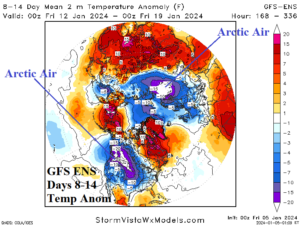Highest Precipitation Probability for Days 6-10 Issued by NOAA/CPC in Memory
01/04/2024, 4:41 am ESTMany U.S. Weather Hazards Ahead (Extreme Cold, Blizzards, and Flooding Rain)
01/07/2024, 9:43 am EST 


Fig. 1-3: The GFS ENS peak cold period ahead (Jan. 12-18) compared with the arctic outbreak of February 2021 (“Uri”) and the GFS ENS northern hemisphere 8-14-day temperature anomaly forecast.
Discussion: A second stratospheric warming (SW) event for northern hemisphere meteorological winter is underway. The first produced an arctic outbreak across Eurasia in early December. The ongoing SW episode has already spawned historic cold from Northwest Russia to Scandinavia and is forecast to expand and intensify through middle January. Unlike the first arctic air outbreak, the ongoing event will eventually feature an upper-level high pressure “ridge bridge” over Alaska to Siberia by later next week enabling a cross-polar flow of arctic air from the Eurasia source region into North America helping to intensify the North-central Canada polar vortex and the attendant longwave low-pressure trough into the U.S. The 8-14-day U.S. temperature anomaly forecast continues to trend colder. The GFS ENS forecast represents a good consensus view for the peak cold period (Jan. 12-18). Indicated is a swath of arctic air from Southwest Canada to the Great Plains. The U.S. gas population weight heating degree day forecast is 244 for that period according to CWG Storm Vista Weather Models. That forecast is 39 HDD colder than the 10-year normal (205). How does this cold outbreak compare with the infamous polar vortex event (named “Uri”) of February 12-18, 2021? The FEB-21 event generated 272 HDD which was 82 above the 10-year normal. The FEB-21 event was much colder across higher population zones, particularly Texas. The FEB-21 southern displacement of arctic air was enhanced by the southern extent of snow cover which is still in question for the cold air outbreak forecast for middle of this month. Arctic air is widespread in Eurasia and North America in the 8-14-day period for the first time since January 2014.
